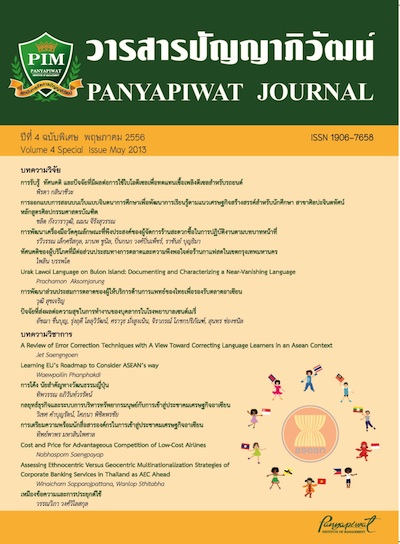เหมืองข้อความและการประยุกต์ใช้
Main Article Content
บทคัดย่อ
บทคัดย่อ
เหมืองข้อความ เป็นเทคนิคการค้นหาความรู้ใหม่จากข้อมูลประเภทข้อความที่มีปริมาณมากโดยอัตโนมัติ โดยการสกัดคำ ค้นหารูปแบบ และความสัมพันธ์ที่ซ่อนอยู่ในชุดข้อความเอกสาร เพื่อให้เกิดความหมายและสามารถนำมาใช้ประโยชน์ได้ โดยสถาปัตยกรรมระบบของเหมืองข้อความมีความคล้ายคลึงกับสถาปัตยกรรมระบบในการค้นหาความรู้ในฐานข้อมูลประเภทข้อความ ซึ่งประกอบด้วย ขั้นตอนการเตรียมข้อมูล ขั้นตอนการค้นหากฎความสัมพันธ์ และขั้นตอนการนำเสนอผลลัพธ์ที่ชัดเจน ส่วนประโยชน์ของเหมืองข้อความนั้น คือการทำให้สารสนเทศในรูปแบบข้อความสามารถเข้าถึง วิเคราะห์ และประมวลผลภายในเวลาอันรวดเร็ว โดยผู้ใช้สามารถเข้าใจและใช้ประโยชน์จากเอกสารที่จัดเก็บไว้เป็นจำนวนมากได้อย่างมีประสิทธิภาพ แนวทางสำคัญในการประยุกต์ใช้เหมืองข้อความ คือ การประยุกต์ใช้ตามหน้าที่ และตามกลุ่มการใช้งาน และขณะนี้ได้มีการพัฒนาเหมืองข้อความขึ้นเป็นเหมืองข้อความแสดงความคิดเห็น ซึ่งผสานเทคนิคของการสืบค้นข้อมูลเข้ากับการประมวลผลภาษาธรรมชาติ ทำให้สามารถสรุปความคิดเห็นที่หลากหลายบนเครือข่ายสังคมออนไลน์ให้เข้าใจง่ายยิ่งขึ้น
คำสำคัญ : เหมืองข้อความ เหมืองข้อมูล การค้นหาความรู้ ฐานข้อมูลประเภทข้อความ
Abstract
Text Mining is a new technique of a search engine done by automatically going through large quantity of information. This is done by extracting an information, finding pattern, as well as hidden meaning and relation within the set documents. This makes it meaningful and very beneficial. The system architecture of text mining is similar to the one of Knowledge Discovery in Textual databases. This is including Text Preprocessing phase, Association Rule Mining phase and Visualization phase. The benefit of text mining is to help improve information technology in the form of text to be easier accessible in an analytical way. The users will be able to understand and benefit from this efficiently. This will be done with the use of large number of collected documents. The main approach to text mining is to apply it according to function and usability. Nowadays, text mining has been developed into an opinion mining. This combines the mean of retrieving information with Natural Language Processing (NLP). Therefore, this will be easier especially with different opinion from an online social network.
Keywords : Text Mining, Data Mining, Knowledge Discovery, Textual databases
Article Details
“ข้าพเจ้าและผู้เขียนร่วม (ถ้ามี) ขอรับรองว่า บทความที่เสนอมานี้ยังไม่เคยได้รับการตีพิมพ์และไม่ได้อยู่ระหว่างกระบวนการพิจารณาลงตีพิมพ์ในวารสารหรือแหล่งเผยแพร่อื่นใด ข้าพเจ้าและผู้เขียนร่วมยอมรับหลักเกณฑ์การพิจารณาต้นฉบับ ทั้งยินยอมให้กองบรรณาธิการมีสิทธิ์พิจารณาและตรวจแก้ต้นฉบับได้ตามที่เห็นสมควร พร้อมนี้ขอมอบลิขสิทธิ์บทความที่ได้รับการตีพิมพ์ให้แก่สถาบันการจัดการปัญญาภิวัฒน์หากมีการฟ้องร้องเรื่องการละเมิดลิขสิทธิ์เกี่ยวกับภาพ กราฟ ข้อความส่วนใดส่วนหนึ่งและ/หรือข้อคิดเห็นที่ปรากฏในบทความข้าพเจ้าและผู้เขียนร่วมยินยอมรับผิดชอบแต่เพียงฝ่ายเดียว”
เอกสารอ้างอิง
วิชุดา โชติรัตน์. (2554), ระบบวิเคราะห์ข่าวออนไลน์โดยใช้ฐานความรู้ออนโทโลยี และการทําเหมืองข้อความ กรณีศึกษาข่าวในพื้นที่ 5 จังหวัดชายแดนภาคใต้ ประเทศไทย, วิทยานิพนธ์หลักสูตรวิทยาศาตรมหาบัณฑิต สาขาวิชาเทคโนโลยีสารสนเทศ บัณฑิตวิทยาลัย มหาวิทยาลัยเทคโนโลยีพระจอมเกล้าพระนครเหนือ.
Ashok Srivastava, Mehran Sahami. (2009). Text mining : classification, clustering, and applications.Chapman & Hall/CRC.
Diane McDonald. (2012). Value and benefits of text mining. Retrieved 28 January 2013, from http://www.jisc.ac.uk/publications/reports/2012/value-and-benefits-of-text-mining.aspx.
Ekamorn Meesomsak, Natthapong Sriphadung, Phatthanaphong Wanchanthuek, Panida Songram, Kaveepoj Bunluewong and Umaporn. (2011). An Information Extraction System for Medical Informatics using Text Mining Techniques: A Case Study of the H1N1 influenza.The 7th National Conference on Computing and Information Technology: NCCIT2011.
Feldman, Ronen & Sanger, James. (2007). The text mining handbook advanced approaches in analyzing unstructured data. New York: Cambridge University Press.
Hany Mahgoub, Dietmar Rösner, Nabil Ismail and Fawzy Torkey. (2008). A Text Mining Technique Using Association Rules Extraction. International Journal of Information and Mathematical Sciences 4(1).
Inyaem, Uraiwan, Meesad, Phayung, Haruechaiyasak, Choochart and Tran, Dat. (2010). Terrorism event classification using fuzzy inference systems, International Journal of Computer Science and Information Security, 7(3), 247-256.
Kongthon, Alisa, Kongyoung, Sarawoot Sangkeettrakarn, Chatchawal Haruechaiyasak, Choochart.(2010). Thailand's Tourism Information Service Based on Semantic Search and Opinion Mining, Proceedings of ITC-CSCC 2010.
Louise A. Francis. (2006). Taming Text: An Introduction to Text Mining, Casualty Actuarial Society Forum, Winter 2006.
Mahesh T R, Suresh MB, M Vinayababu. (2009). Text Mining : Advancements, Challenges and Future Directions. International Journal of Reviews in Computing © 2009-2010 URIC & LLS.
Michael W. Berry and Jacob Kogan. (2010). Text Mining Applications and Theory. United Kingdom: John Wiley & Sons.
Pilapan Phonarin, Supot Nitsuwat and Choochart Haruechaiyasak. (2011). Text Categorization using Feature Selection Techinque for Agricuture Bibliographic Data. The 7th National Conference on Computing and Information Technology: NCCIT2011.
Saša Petrovic. (2007). Collocation extraction measures for text mining applications. University of Zagreb Faculty, of Electrical Engineering and Computing.
Sergio Bolasco, Alessio Canzonetti, Federico M. Capo. Francesca Della Ratta-Rinaldi, Bhupesh K.Singh. (2002). Understanding Text Mining: a Pragmatic Approach. Roma Italy: U. La Sopienza.
Vishwadeepak Singh Baghela, Dr. S.P. Tripathi. (2012). Text Mining Approaches to Extract Interesting Association Rules from Text Documents, ICSI International Journal of Computer Science, 9(3).


